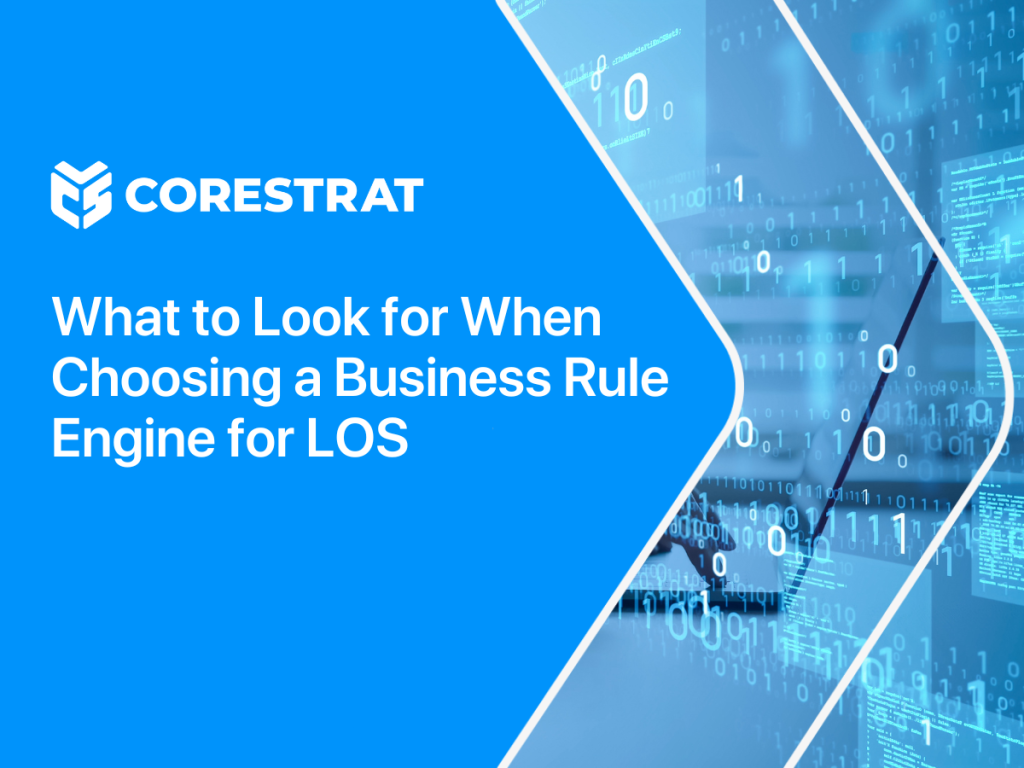Business Rule Engines (BREs) are often considered the strategic brain behind modern Loan Origination Systems (LOS). Their ability to evaluate loan applications and make real-time decisions based on predefined conditions makes them indispensable. In today’s competitive lending landscape, where institutions are increasingly automating their lending workflows to reduce operational costs and boost efficiency, the role of a BRE becomes even more crucial. A well-implemented BRE can significantly influence the success of a lending operation, enhancing productivity, ensuring compliance, and driving profitability.
But what if your current LOS doesn’t include a robust BRE? Or you’re evaluating alternatives for greater performance? Choosing the right BRE isn’t just a technical decision—it’s a strategic one that shapes your organisation’s agility, risk management, and customer experience.
In this article, we’ll explore the key factors every lender must consider when selecting the ideal BRE for their LOS.
Factors to Consider When Choosing a Business Rule Engine for LOS
Not every business rule engine on the market is designed to effectively support lending workflows within a Loan Origination System. To ensure your LOS performs at its best, it’s essential to evaluate several critical factors before selecting the right BRE.
Factors to Consider While Choosing the BRE
|
Criteria |
Feature |
|
Domain Specialisation |
Workflows tailored for lending |
|
Integration |
API-first, cloud-native design |
|
Scalability |
10,000+ decisions/sec, low latency |
|
Access Control |
Role-based rule and audit management |
|
AI Compatibility |
Supports ML integration, hybrid logic |
Domain Specialisation
Generic rule engines may offer flexibility, but they often fall short in handling the intricacies of financial services. Lenders face regulatory constraints, credit risk management models, real-time fraud checks, and underwriting workflows that demand domain-specific logic.
Specialised BREs that are designed to best fit LOS come with:
- Pre-configured rules for KYC checks, debt-to-income ratios, and collateral valuation
- Built-in compliance frameworks for the Fair Lending Act and BASEL III requirements
- Industry-specific decision trees for auto loans vs. mortgages vs. SME lending
Integration Capabilities: API-First and Cloud-Native Design
Modern loan origination system environments are interconnected with numerous external and internal systems, ranging from CRM platforms and KYC services to credit bureaus, fraud detection tools, and core banking systems. To enable real-time lending, your BRE must be API-first, ensuring seamless and scalable integration with each of these components. These integrations should not only be robust but also optimised for performance. For example, a latency of 50 to 100 milliseconds is considered ideal for API calls in real-time decisioning, and this applies to the BREs used in LOS as well.
Why Choose a Cloud-Native Business Rule Engine (BRE)?
- Seamless Deployment: Cloud-native BREs can be rapidly deployed across your infrastructure with minimal setup and configuration, reducing time-to-market.
- Anywhere, Anytime Access: Users can securely access the BRE from any location or device, enabling remote work and real-time collaboration.
- Automatic Updates and Maintenance: Cloud providers manage software updates, patches, and backups, freeing your IT team to focus on strategic initiatives.
- Integration Flexibility: Easily connect with other cloud-based services and APIs, enabling a more agile and interconnected Loan Origination System.
- Disaster Recovery and High Availability: Cloud-native BREs typically include built-in redundancy and failover mechanisms, minimising downtime and data loss risks.
Scalability: Can It Handle Thousands of Decisions per Second?
As digital lending scales, your BRE must support high-throughput processing without latency. Whether you’re handling microloans, BNPL, or mortgages, peak performance should not lead to system slowdowns. For example loan platforms might have to handle 3,000+ decisions/second during peak seasons without performance degradation.
For example, Corestrat’s Rule.ai, a customisable business rule engine (BRE) designed for industry-specific purposes, helps lending institutions design rules and strategies to automate decision-making. It also scales with the institution’s growth and efficiently handles loan applications, allowing lenders to focus on achieving their business goals.
User Access Control: Role-Based Access for Rule Editors vs. Auditors
Security and governance in lending are non-negotiable. Rule management should be role-based, ensuring that only authorised users can modify logic while auditors and risk officers retain view-only access.
Role-Based Access Configuration
|
Role |
Permissions |
|
Admin |
Create/Edit/Delete rules, Manage users |
|
Rule Editor |
Edit business rules |
|
Auditor |
Read-only access, View logs |
|
IT Admin |
Infrastructure and deployment |
For example, an underwriter needs to adjust a rule for self-employed applicants, while a compliance officer must validate that the changes don’t violate lending norms.
With role-based access, the BRE ensures:
- Separation of duties
- Audit trails for every rule change
- Compliance readiness for regulators
Sample Implementation Checklist:
- 4-eye principle: Require dual approval for production rule changes
- Version control: Maintain 180-day change history with rollback
- Field-level encryption: Protect sensitive data like Social Security Numbers and credit scores
Support for AI Models: Hybrid Engines for Rule + ML Synergy
The future of automated decisioning lies in hybrid engines—those that can blend deterministic rules with probabilistic machine learning (ML). For instance:
- Rules: “Reject applications with CIBIL score < 600”
- ML: Predict default risk for borderline applications
By integrating models directly into the decision flow, you gain both explainability and intelligence.
Conclusion
Business rule engines (BREs) are an integral part of any loan origination system (LOS) in the lending industry. However, choosing the right BRE is essential to maximise its benefits. By investing in the right business rule engine, you’re not just automating lending decisions—you’re also selecting a strategic partner that supports the growth and success of your lending organisation.



